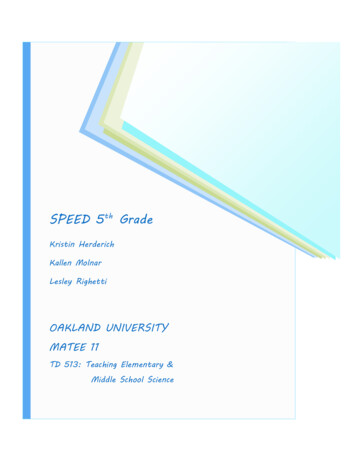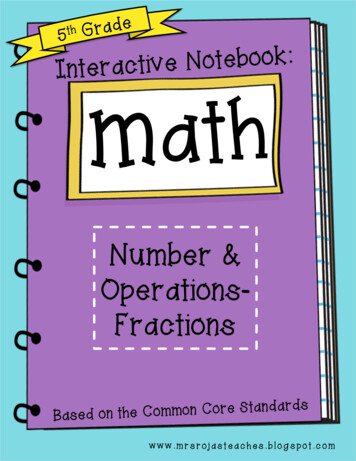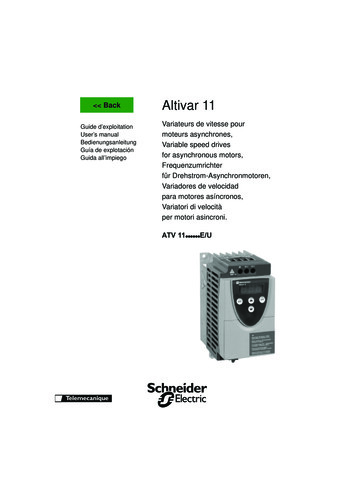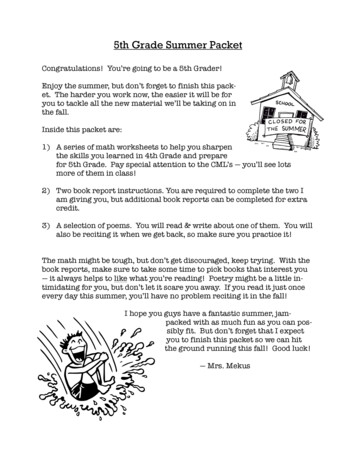
Transcription
SPEED 5th GradeKristin HerderichKallen MolnarLesley RighettiOAKLAND UNIVERSITYMATEE 11TD 513: Teaching Elementary &Middle School Science
SpeedTable of ContentsSection I: Unit OverviewUnit Cover Page 5Background Information 8Misconceptions .9Pacing Guide .10Parent Letter 15Field Trip Plan .17Teacher Resources .20Student Resources .21Section II: AssessmentsUnit Pre-Test 23Unit Pre-Test Answer Key .26Unit Post-Test .29Unit Post-Test Rubric .30Section III: 5E Lesson PlansHow Fast is Fast?.39K’NEX in Motion .46Effects of Racecar Seatbelts 50Page 2
Section IV: Curriculum Connection Lesson PlansMathematics Connection 56Mathematics Connection Rubric .60Physical Education Connection .61Physical Education Connection Rubric 65Writing Connection .66Writing Connection Rubric 68Page 3
SpeedUnit OverviewIN THIS SECTION: Unit Cover Page .5 Background Information .8 Misconceptions .9 Pacing Guide 10 Parent Letter .15 Field Trip Plan 17 Teacher Resources .20 Student Resources .21Page 4
Unit Cover PageUnit Title: SpeedGrade Level: 5Subject Content and Topic Area(s): Physical ScienceKey Words:Critically Important: Change of Direction, Change of Motion, Change of Speed,Graph, Relative Position, Constant Speed, Direction of Motion, SpeedInstructionally Useful: Acceleration, Deceleration, VelocityDesigned By: Lesley Righetti, Kallen Molnarand Kristin HerderichSchool District: ROCHESTERTime Frame: 11 WeeksSchool: NORTH HILL ELEMENTARYBrief Summary of Unit:Scientific InquiryK-7 Standard S.IP: Develop an understanding that scientific inquiry and reasoninginvolves observing, questioning, investigating, recording, and developing solutionsto problems.S.IP.M.1 Inquiry involves generating questions, conducting investigations,and developing solutions to problems through reasoning and observation.S.IP.05.11 Generate scientific questions based on observations, investigations,and research.S.IP.05.12 Design and conduct scientific investigations.S.IP.05.13 Use tools and equipment (spring scales, stop watches, meter sticks andtapes, models, hand lens) appropriate to scientific investigations.S.IP.05.14 Use metric measurement devices in an investigation.S.IP.05.15 Construct charts and graphs from data and observations.Inquiry Analysis and CommunicationK-7 Standard S.IA: Develop an understanding that scientific inquiry andinvestigations require analysis and communication of findings, using appropriatetechnology.S.IA.M.1 Inquiry includes an analysis and presentation of findings that leadto future questions, research, and investigations.S.IA.05.11 Analyze information from data tables and graphs to answer scientificquestions.Page 5
S.IA.05.12 Evaluate data, claims, and personal knowledge through collaborativescience discourse.S.IA.05.13 Communicate and defend findings of observations and investigationsusing evidence.Reflection and Social ImplicationsK-7 Standard S.RS: Develop an understanding that claims and evidence for theirscientific merit should be analyzed. Understand how scientists decide whatconstitutes scientific knowledge. Develop an understanding of the importance ofreflection on scientific knowledge and its application to new situations to betterunderstand the role of science in society and technology.S.RS.M.1 Reflecting on knowledge is the application of scientific knowledgeto new and different situations. Reflecting on knowledge requires carefulanalysis of evidence that guides decision-making and the application ofscience throughout history and within society.S.RS.05.11 Evaluate the strengths and weaknesses of claims, arguments, anddata.S.RS.05.15 Demonstrate scientific concepts through various illustrations,performances, models, exhibits, and activities.Physical Science Content StandardsK-7 Standard P.FM: Develop an understanding that the position and/or motion ofan object is relative to a point of reference. Understand forces affect the motionand speed of an object and that the net force on an object is the total of all of theforces acting on it. Understand the Earth pulls down on objects with a force calledgravity. Develop an understanding that some forces are in direct contact withobjects, while other forces are not in direct contact with objects.P.FM.M.4 Speed – Motion can be described by a change in position relativeto a point of reference. The motion of an object can be described by itsspeed and the direction it is moving. The position and speed of an objectcan be measured and graphed as a function of time.P.FM.05.41 Explain the motion of an object relative to a point of reference.P.FM.05.42 Describe the motion of an object in terms of distance, time anddirection, as the object moves, and in relationship to other objects.P.FM.05.43 Demonstrate how motion can be measured and represented on agraph.Math Connection:D.RE.05.01 Read and interpret line graphs, and solve problems based on linegraphs, e.g. distance - time graphs, and problems with two or three line graphs onsame axes, comparing different data.D.RE.05.02 Construct line graphs from tables of data; include axis labels andPage 6
scale.D.AN.05.03 Given a set of data, find and interpret the mean (using the concept offair share) and mode.M.UN.05.04 Convert measurements of length, weight, area, volume, and timewithin a given system using easily manipulated numbers.Physical Education Connection:M.MS.05.02 demonstrate mature form of locomotor skills of walk, run, leap, slide,gallop, hop, skip, flee, and dodge using movement concepts in controlled settings.A.AN.05.04 utilize physiological indicators associated with moderate tovigorous physical activity (e.g., sweating, increased heart rate, increasedrespiration, palpating pulse) to adjust participation/effort in controlled settings.Writing Connection:W.PR.05.01 set a purpose, consider audience, and replicate authors’ styles andpatterns when writing a narrative or informational piece.W.PR.05.02 apply a variety of pre-writing strategies for both narrative andinformational writing (e.g., graphic organizers such as maps, webs, Venn diagrams)in order to generate, sequence, and structure ideas (e.g., role and relationships ofcharacters, settings, ideas, relationship of theory/evidence, or compare/contrast).W.PR.05.05 proofread and edit writing using grade-level checklists and otherappropriate resources both individually and in groups.W.GN.05.04 use the writing process to produce and present a research project;use a variety of resources to gather and organize relevant information into centralideas and supporting details for a teacher-approved narrowed focus question andhypothesis.Big Ideas: Motion is described relative to something else (point of reference).A change in motion is due to unbalanced forces.No change in motion and an object at rest are due to balanced forces.Construct and analyze graphs of motion.Given a point of reference describe motion in terms of speed, distance, timeand direction.Michigan Department of Education. (2010). 5-7 Science grade level content expectations companiondocument. Retrieved January 26, 2013, from http://www.michigan.gov/documents/mde/57 Science GLCE Companion Document v.1.09 2 264472 7.pdfMichigan Department of Education. (2010). Fifth grade science grade level content expectations.Retrieved January 26, 2013, fromhttp://www.michigan.gov/documents/mde/Complete Science GLCE 12-12-07 218314 7.pdfPage 7
Background InformationStudents will participate in an in-depth study of motion as related to a point ofreference, distance, time, and direction. Their exploration into motion also presentshigh interest content for students to hone skills in metric measurement and the useof tools and equipment appropriate to scientific investigations. The elementaryschool experience of investigating balanced and unbalanced forces, and theirrelationship to the size of change in motion, provide concrete experiences on whicha more comprehensive understanding of force can be based at the middle schoollevel. Students can move from qualitative descriptions of moving objects in theearly elementary grades to quantitative descriptions of moving objects and theidentification of the forces acting on the objects.The completion of the study in motion involves the exploration and identification ofcontact and non-contact forces and how they change the motion of objects.Students’ everyday experiences in motion lead them to believe that friction causesall moving objects to slow down and stop. In-depth explorations into reducing theforce of friction can help the students understand and demonstrate that a movingobject requires friction to keep it moving. The understanding of objects at restrequires the students recognize that there are balanced forces in equilibrium, suchas a book on a table or chair on the floor. (MDE, Fifth pg. 51) Motion is relative to something else (point of reference). (MDE, 5-7 pg. 7) A point of reference offers all observers a common frame through whichto judge motion and its changes. A point of reference is the point fromwhich movement is determined. (MDE, 5-7 pg. 7) Speed is the ratio of distance covered per unit of time, S D/T. (MDE, 5-7pg. 7) An object’s motion can be described in terms of speed and direction.(MDE, 5-7 pg. 7) The term distance describes amount of space between two things orpoints. Distance is measured in millimeters, centimeters, meters, andkilometers. (MDE, 5-7 pg. 8)Michigan Department of Education. (2010). Fifth grade science grade level content expectations.Retrieved January 26, 2013, fromhttp://www.michigan.gov/documents/mde/Complete Science GLCE 12-12-07 218314 7.pdfMichigan Department of Education. (2010). 5-7 Science grade level content expectations companiondocument. Retrieved January 26, 2013, from http://www.michigan.gov/documents/mde/57 Science GLCE Companion Document v.1.09 2 264472 7.pdfPage 8
MisconceptionsMisconception #1: Smaller objects will go faster and larger objects will go slower.Misconception #2: Students do not see motion as belonging to a number ofdifferent categories – at rest, constant velocity, speeding up, slowing down,changing direction, etc. Instead, they see motion as moving or not moving.(Driver)Misconception #3: If the speed is increasing than acceleration is also increasing.(Driver)Misconception #4: Speed and velocity are the same thing. (Common)Common Student Misconceptions. (2013). In Ohio Resource Center. Retrieved January 27, 2013, ptions.aspx?cid 5Driver, R., Squires, A., Rushworth, P., & Wood-Robinson, V. (1994). Making sense of secondaryscience: Research into children’s ideas. In Misconceptions about Motion. Retrieved January 27,2013, from .pdfPage 9
Pacing GuideWeek ayHow Fast isFast?WednesdayHow Fast isFast?ThursdayHow Fast isFast?FridayHow Fast M.05.41P.FM.05.43TuesdayHow Fast isFast?WednesdayHow Fast isFast?ThursdayHow Fast isFast?FridayHow Fast S.05.11P.FM.05.41P.FM.05.43Week 2Activity/LessonName:GLCE's:MondayHow Fast A.05.13S.RS.05.11P.FM.05.41P.FM.05.43Page 10
Week 3Activity/LessonName:GLCE's:MondayHow Fast nshipbetweenSpeed,Distance, stance, stance, andTimeLocomotorMovementsand TheirEffects onHeart 5.04D.RE.05.01D.RE.05.02WednesdayK’NEX inMotion EngageThursdayK’NEX inMotionEngageFridayK’NEX inMotion A.05.11S.RS.05.15Week Movementsand TheirEffects onHeart RateLocomotorMovementsand TheirEffects onHeart 5.04D.RE.05.01D.RE.05.02Page 11
Week 5Activity/LessonName:GLCE's:MondayK’NEX inMotion ExploreTuesdayK’NEX inMotion ExplainWednesdayK’NEX inMotion ExplainThursdayK’NEX inMotion ElaborateFridayK’NEX inMotion .RS.05.15MondayK’NEX inMotion ExploreTuesdayK’NEX inMotion ExplainWednesdayK’NEX inMotion ExplainThursdayK’NEX inMotion ElaborateFridayK’NEX inMotion .RS.05.15MondayK’NEX inMotion ElaborateTuesdayK’NEX inMotion –Elaborate/EvalWednesdayK’NEX inMotion EvaluationThursdayK’NEX inMotion .RS.05.15Week 6Activity/LessonName:GLCE's:Week PR.05.05W.GN.05.04P.FM.05.41Page 12
Week .PR.05.05W.GN.05.04P.FM.05.41Week Effects ofRacecarSeatbeltsWednesdayEffects ofRacecarSeatbeltsThursdayEffects ofRacecarSeatbeltsFridayEffects ts ofRacecarSeatbeltsWednesdayEffects ofRacecarSeatbeltsThursdayEffects ofRacecarSeatbeltsFridayEffects IA.05.13S.RS.05.11P.FM.05.42P.FM.05.43Week 10Activity/LessonName:GLCE's:MondayEffects ge 13
Week 11Activity/LessonName:GLCE's:MondayEffects esdayEffects ofRacecarSeatbeltsWednesdayEffects RS.05.11P.FM.05.42P.FM.05.43ThursdayPost TestFridayPost Test dueon Mondayn/an/aPage 14
Parent LetterSpeedDear Parents/Guardians,We are starting a six-week unit on speed. During this unit, our class will beparticipating in numerous inquiry based science lessons and activities to help eachstudent enhance their ability to think through different questions and experiments.We want to maximize student involvement and understanding though hands-oninstruction.As you know a collective collaboration between students, teachers, and parents isnecessary to insure your children are successful. During this unit I ask that youremain involved. This can be accomplished simply by having your child explain whatthey are learning each day or by asking them to restate the different experimentswe are currently doing. Periodically asking different speed related questions ordiscussing current events related to speed can also be helpful. Information on ourunit and different facts about speed can be found posted on our classroom webpage. Feel free to post questions or new discoveries on our newly started Speedforum!If anyone would like to volunteer or if you have any experience related to this unityou would like to share, please do not hesitate to contact me. We are also lookingfor at least 2-3 volunteers to accompany us on our class field trip to Discount Tire.The more involvement parents have the better for the students.I am looking forward to exploring this unit with the class over the next few weeks.If you have any questions or would like more information please feel free to contactme at kal.mich@gmail.com or call (734)-845-4430. Attached are different studentresources that are extremely helpful in learning more about this unit.Student ResourcesSpeed on about Speed ines.htmlPage 15
Mechanics and Motion on intro.htmlSpeed Topic Resources:http://www.scilinks.org/Harcourt Hsp/HspStudentRetrieve.aspx?Code HSP508Design a parkphysics/coaster/Sincerely,Kal Michigan5th Grade Science TeacherPage 16
Field TripName:Community Resource Information SheetSite/Speaker: Discount TireStreet Address: 3809 South Rochester RoadCity, State, Zip: Rochester Hills, MI, 48307Telephone: (248) 844-8294Web Site/Email: www.discounttire.comField Trip InformationDescription: Our 5thgrade classroom will visit a local tire shop to help learn aboutSpeed. Discount Tires is a national company that specializes in automobile tiresand have numerous experts and mechanics working for them. We will visit DiscountTire during the school day to have a short lecture/discussion on how speed isaffected by pressure, temperature, and tire width. This will be followed by differentvisuals and examples by the employees of Discount Tire.Objective/Purpose of the Field Trip: This field trip will utilize the informationprovided by the employees of Discount Tire Company. The tires of a vehicle play acrucial role in the speed of the vehicle. There are numerous variables relating totires that will greatly affect the speed of the car. Working with tire mechanic andexperts will help our students make the connections between what we are learningabout in our unit and how this affects our daily lives.Fees: N/AAdvance Notice Required: YesAge Group Range/Limits: 4th-12th gradeAvailable Times: Mon-Fri 10AM-1:30PMGroup Size Limit: 20-35 studentsLength of Tour: 1-2 hoursPage 17
Guides Available: YesDining Facilities: NoRestroom Facilities: YesAdult/Student Ratio Required: 10-1Miscellaneous Information/Notes: If students would like to bring snacks or foodthere will be a break provided.Page 18
North Hill Elementary School -Field Trip Permission FormTo the Parent(s)/Guardian of:The science class, under the supervision of will be takinga Field Trip To: Discount TireAddress: 3809 South Rochester Road, Rochester Hills, MI 48307Date: Departing: Returning:My child haspermission to attend the above field trip. I authorize any medical treatment in caseof an emergency, and agree that I am responsible for the cost of such treatment.Current Medical Information:Ins.Policy #Special Health Concerns:During this field trip, in the event of emergency, I can be reached at (phone #)Alternative contact:(Name, Phone Number)I agree to release, hold harmless and indemnify North Hill Elementary, its agents,representatives and employees from any and all liability, loss, damages, claims oractions for bodily injury and/or property damage arising out of participation in thistrip, in accordance with current state and federal law.Parent/Guardian Signature Date:Please return signed form no later than:( Date )Fax # (248) 203-7335This signed form must be submitted for the student to participate in this field trip.Page 19
Teacher ResourcesMichigan Department of Education. (2010). Fifth grade science grade levelcontent expectations. Retrieved January 26, 2013, fromhttp://www.michigan.gov/documents/mde/Complete Science GLCE 12-12-07 218314 7.pdfMichigan Department of Education. (2010). 5-7 Science grade level contentexpectations companion document. Retrieved January 26, 2013, fromhttp://www.michigan.gov/documents/mde/57 Science GLCE Companion Document v.1.09 2 264472 7.pdfLesson Plans Using K’Nex Related to Speed:http://www.knex.com/Educators/Exploration of Speed Lesson:http://www.teachnology.com/lessons/lsn pln view lessons.php?action view&cat id 9&lsn id 25570Balloon Race Car Lesson on cers.htmPage 20
Student ResourcesSpeed on about Speed ines.htmlMechanics and Motion on intro.htmlSpeed Topic Resources:http://www.scilinks.org/Harcourt Hsp/HspStudentRetrieve.aspx?Code HSP508Design a parkphysics/coaster/Page 21
SpeedAssessmentsIN THIS SECTION: UnitUnitUnitUnitPre-Test 23Pre-Test Answer Key .26Post-Test .29Post-Test Rubric .30Page 22
Unit Pre-TestShort Answer1. Name as many different types of speed that you can?2. How do you use speed on a daily basis?3. What is the difference between speed and velocity?4. Tell me everything you know about speed in relation to distance andtime.GraphsWhat do the following graphs represent?Page 23
If the average speed of a cyclist is 10 km/hr, label the following graphappropriately:Define the following terms:Speed:Change of Direction:Change of Motion:Change of Speed:Relative Position:Constant Speed:Page 24
Direction of Motion:Acceleration:Velocity:Deceleration:Average Speed:Point of Reference:An airplane is flying at a speed of 170 meters per second (m/s) relative to theground. A flight attendant is walking at a speed of 2 meters per second to the rearof the plane. Relative to the ground, what is the speed of the flight attendant?Train A is moving west at 10 mph and collides with train B moving east at 30 mph.What speed and direction will Train A move immediately after the collision?Page 25
Unit Pre-Test Answer KeyShort AnswerName as many different types of speed that you can?How do you use speed on a daily basis?What is the difference between speed and velocity?Tell me everything you know about speed in relation to distance and time.GraphsWhat do the following graphs represent?Page 26
If the average speed of a cyclist is 10 km/hr, label the following graphappropriately:Define the following terms:Speed- Distance travelled per unit time.Change of Direction- the act of changing the direction in which something isoriented.Change of Motion- A change in position compared to the starting location, whichhappens over a period of time.Change of SpeedRelative PositionConstant Speed- Distance travelled per unit time at a constant rate.Direction of MotionAcceleration- the change in velocity, per unit time.Velocity- is a vector measurement of the rate and direction of motion or, in otherterms, the rate and direction of the change in the position of an object.Deceleration- A negative acceleration is called a deceleration.Average Speed- The average speed of a vehicle is calculated over the wholedistance and time of the journey.Page 27
Point of Reference- A point that does not change; is used to calculate from.An airplane is flying at a speed of 170 meters per second (m/s) relative to theground. A flight attendant is walking at a speed of 2 meters per second to the rearof the plane. Relative to the ground, what is the speed of the flight attendant?168 m/sTrain A is moving west at 10 mph and collides with train B moving east at 30 mph.What speed and direction will Train A move immediately after the collision?20 mph eastSome questions adapted Measure-Change-in-MotionPage 28
Unit Post-TestTic-Tac-Toe MenuSpeedDirections: Choose activities in a Tic-Tac-Toe design. When you have completed theactivities in a row – horizontally, vertically, or diagonally, you may choose to befinished. Or you may decide to complete more activities. Star the activities you planto complete. Color in the box when you finish the activity.Select 3 examples frommovies or television wherethe concept of Speed isunrealistically portrayedand write a one-pagesummary and what youfound.Research the Speed of 5different types of Boats.Create a bar graphcomparing/contrasting thedifferences and present itto the class.Write a song about Speedand perform it for .05.15)(P.FM.05.41)(S.RS.05.15)Interview a representativefrom a local SpeedAwareness Program andpresent your findings toyour classmates.YOUR CHOICEThink of your own way todemonstrate theknowledge in this chapter.Check with me before youbegin.Research 3 animal’smaximum speeds andcreate a poster comparingthem to the maximumspeed a human 5.13)Design and conduct ascientific experiment onSpeed. Present yourexperiment and findingsto the class.Compare how fast carsare going on a road withthe posted speed limited.You must construct anexperiment to measurehow fast the cars aregoing.Research how aPoliceman’s Radar guncalculates speed and writea short paragraph abouthow it .12)(P.FM.05.41)(S.IA.05.13)Page 29
Unit Post-Test RubricsSelect 3 examples from movies or television where the concept of Speed isunrealistically portrayed and write a one-page summary and what youfound RubricP.FM.05.41S.RS.05.12PossiblePointsStudent picks an appropriate movie or TelevisionShow13 Examples of how speed is incorrectly used6Examples are typed or neatly written in pen3Total:PointsEarned10Comments:Page 30
Research the Speed of 5 different types of Boats. Create a bar graphcomparing/contrasting the differences and present it to the class RubricP.FM.05.43S.IP.05.15PointsPossible5 different types of BoatsBar Graphs correctly display the differences in speedPresentation to classTotal:PointsEarned510520Comments:Page 31
Research 3 animal’s maximum speeds and create a poster comparing themto the maximum speed a human runner �s research facts are correct6Uses 3 different animals6Student uses proper use of graphs6Poster is colorful and creative2Total:PointsEarned:20Comments:Page 32
Interview a representative from a local Speed Awareness Program andpresent your findings to your classmates RubricP.FM.05.41S.RS.05.19PossiblePoints:Interview of Representative10Notes on Interview5Presentation to class5Total:PointsEarned:20Comments:Page 33
Write a song about Speed and perform it for the class RubricP.FM.05.41S.RS.05.15PossiblePointsSong has accurate facts about speed5Performance to class5Total:PointsEarned10Comments:Page 34
Compare how fast cars are going on a road with the posted speed limited.You must construct an experiment to measure how fast the cars are ruction of Experiment20Performance of Experiment15Presentation to
Math Connection: D.RE.05.01 Read and interpret line graphs, and solve problems based on line graphs, e.g. distance - time graphs, and problems with two or three line graphs on same axes, comparin











